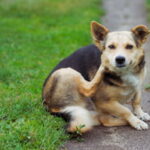If your dog is growling around food, he is exhibiting a behavior known as “food aggression.” This is a serious problem that needs to be addressed immediately. Growling leads quickly to snapping and biting. The good news is that if your dog shows aggression around food, the method below will get him to stop.
First, make sure you have an established routine of feeding your dog twice a day at about the same times every day. Dogs do best when they have a routine because it gives them a feeling of security and structure. Feeding your dog twice a day prevents him from being excessively hungry, which can lead to irritability and desperation. If your dog thinks that this is all the food he is going to get for a while and is very hungry he will be especially possessive of it.
You must take a completely hands-off approach to stopping your dog’s food aggression. This means you never touch him or his bowl at all when he is eating. Do not pet him. Do not punish him. The punishment and reinforcement are contained within the training.
Start by filling your dog’s bowl with food and having a few tasty treats nearby. I like to use something savory like chicken scraps. Set down your dog’s food bowl and toss in a few treats while he is eating. Don’t stand close enough to provoke your dog into growling at you, don’t lean over him or otherwise encroach in his space. This only aggravates his aggressive tendencies around food. In the dog world, once a dog is eating food that food belongs only to him. This is why so many dogs have a problem with their owners removing their food bowls, thereby exhibiting the problem behavior of food aggression. This is also why theories of pack dominance are flawed. Even in the wild, an alpha wolf doesn’t go up to a subordinate wolf and steal what his subordinate is eating.
Your dog will eventually calm down to the fact that you stand around him when he’s eating. Depending on the level of food aggression you are dealing with, this could be a week to over a month. Watch your dog for signs of relaxation, like his tail hanging loosely instead of stiff or up and wagging, his shoulders drooped instead of hunched, and especially your dog looking at you plaintively while eating. The best you can hope for is if your dog looks up at you as if you to say, “What? No more treats?”
Then it is time to go to the next step. It’s time to get closer. Toss treats in from a safe distance, making your presence known to the dog. Ideally at this point he is starting to think that you are a great thing to have around when he is eating, instead of the threat he used to perceive you as.
When you feel the dog is ready you can try to hand feed him. This can be at his feeding time in the morning or evening but his food bowl does not have to be present. You can start by dropping food in front of him and after a while insisting he takes it from your hand. You must never tolerate any teeth when your dog takes food from your hand. If he does, say “ow!” very loudly, make a loud yipping sound, or scream out “gentle!” and turn away from your dog. If you are not sure you can go ahead with this
part of the training, don’t.
Over time you should be getting your hands closer and closer to your dog’s food bowl. Do this slowly. Do this slowly. I cannot stress this enough. This process of “getting closer” can take a long time. Watch your dog to see when he is comfortable with you getting closer. Eventually, he will be ready for two big tests.
In the first test, put your hand directly in the dog’s bowl and put a treat in it. Good reactions include your dog continuing to eat around your hand, and also if he stops eating and looks up at you quizzically. If your dog stiffens and stares at your hand, you need to go back several steps and keep training him to feel comfortable with you around his food bowl. Otherwise you have almost totally cured his food aggression. This first test is a test, and thus you do not need to do it every time he is eating the way you did with tossing food at him. You can do both now interchangeably as you prepare him for the second test of curing his food aggression.
For the second test physically remove your dog’s food bowl. Put some treats in it, ask him to sit or another command that he knows, and give him back his bowl. When you can remove your dog’s bowl without him even stiffening, you have cured his food aggression.
Congratulations! You have probably saved his life. How did you do it? You taught your dog that having people around his bowl is a good thing. When people are around him when he is eating, good things happen. He does not need to feel possessive of his bowl and food because not only are they not going to threaten him and take it away, they are going to make things even better for him. You have used positive reinforcement methods to stop your dog’s food aggression. I would continue working with him even after he passes his tests, by occasionally tossing in tasty food, hand feeding him, putting food directly in, and taking away his bowl once in a while.
Tackling the problem of food aggression is difficult, but can easily be conquered with perseverance, dedication, and understanding. Always consider enlisting the help of a professional dog behaviorist or trainer who uses positive reinforcement methods. This is a very serious problem not to be undertaken lightly.




